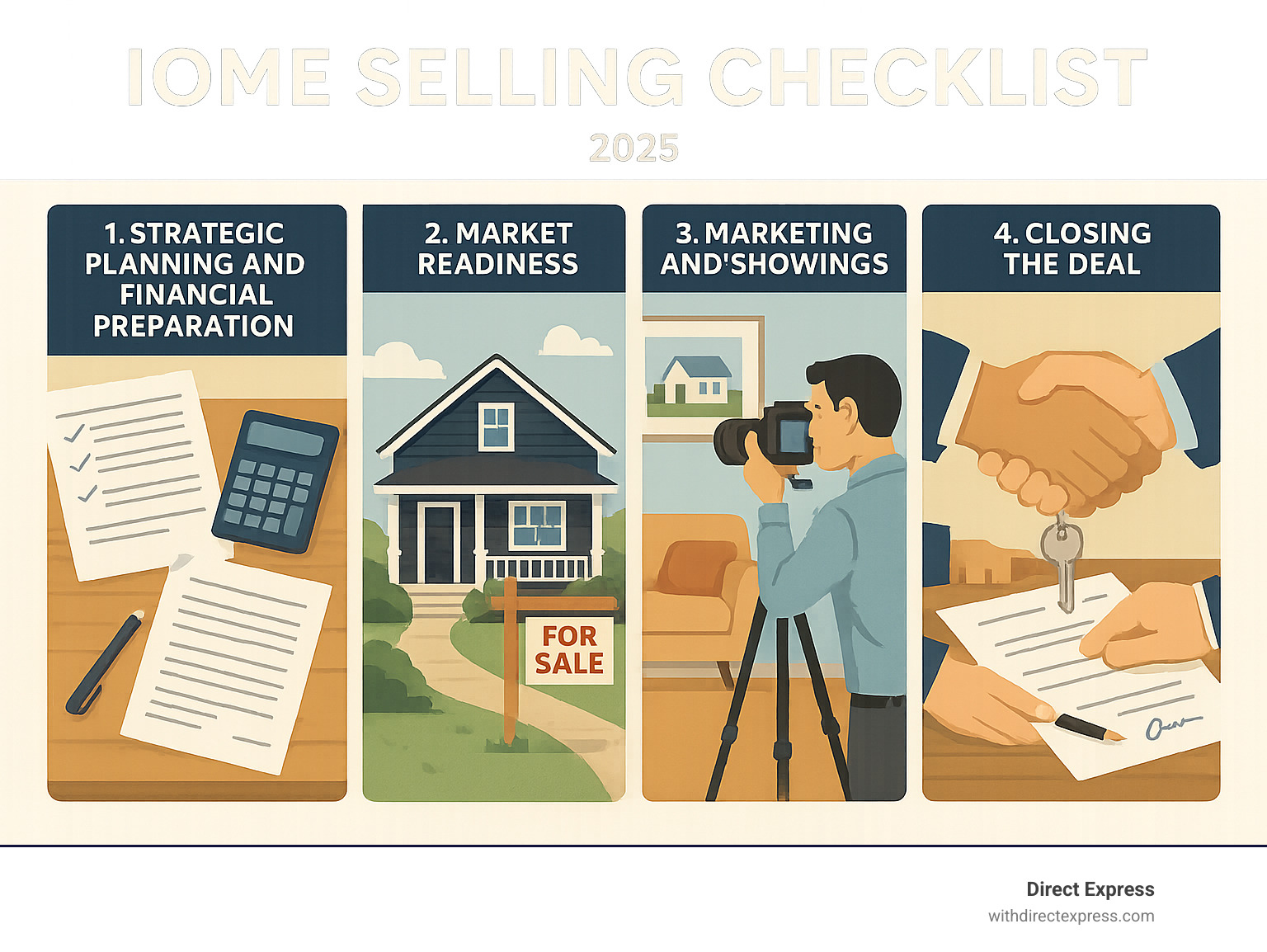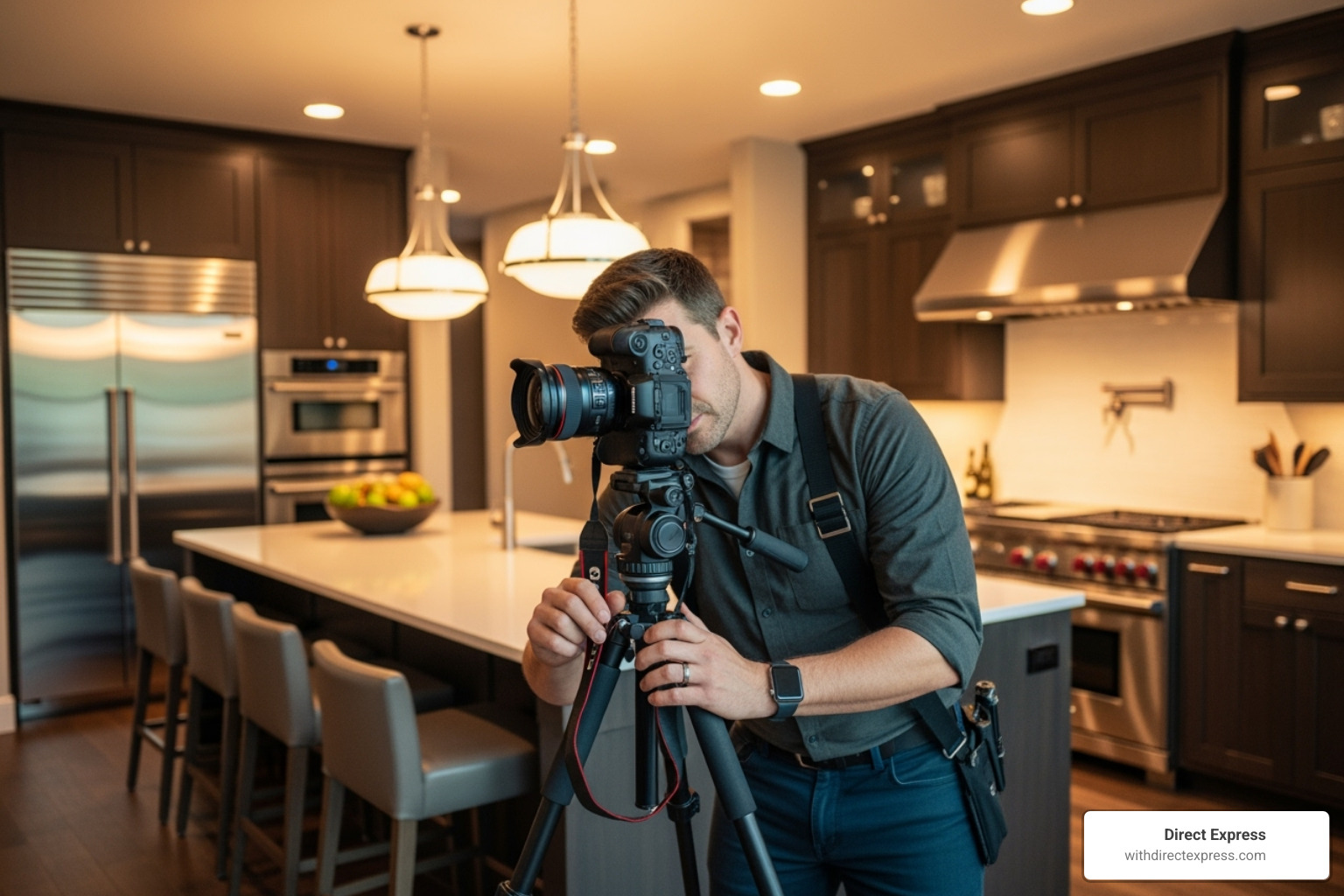Why Having a Home Selling Checklist is Essential for Your Success
A home selling checklist is your roadmap to maximizing profit and minimizing stress during one of life’s biggest financial transactions. Here are the key phases every successful home seller should follow:
Essential Home Selling Phases:
- Strategic Planning – Find an agent, price competitively, gather financial documents
- Market Preparation – Improve curb appeal, declutter, complete repairs, stage your home
- Marketing & Showings – Professional photos, online listings, manage showings safely
- Closing the Deal – Evaluate offers, handle inspections, complete final paperwork
The research shows that homes that are staged sell 25% faster and for 2-5% more than unstaged homes. With 95% of buyers starting their search online, proper preparation isn’t optional – it’s essential for success.
Competition in today’s real estate market can be fierce, with hundreds of other sellers vying for the same pool of buyers. What separates successful sellers from those who struggle is having a systematic approach that covers every detail from initial planning to handing over the keys.
Getting your home ready involves much more than just putting up a “For Sale” sign. You need to think strategically about pricing, prepare your property to make the best first impression, market effectively to reach qualified buyers, and steer the complex negotiation and closing process.
I’m Joseph Cavaleri, Broker and CEO of Direct Express Realty, where I’ve guided countless homeowners through successful sales over two decades of real estate experience. My comprehensive home selling checklist approach has helped clients maximize their profits while reducing the stress and uncertainty that often comes with selling a home.

Phase 1: Strategic Planning and Financial Preparation

Before thinking about staging, the first phase of your home selling checklist is building a solid foundation. This behind-the-scenes work with spreadsheets and contracts is where successful sales begin. Proper planning helps you avoid roadblocks later.
Finding the Right Real Estate Agent
Your real estate agent is a strategic partner who can be worth thousands in your final sale price. It’s essential to interview multiple agents to find the right fit for your property and neighborhood. Ask for and check references to learn about their communication style and problem-solving skills. A great agent will have impressive market knowledge, understanding not just prices but why some homes sell faster than others. When discussing commission rates, the cheapest option isn’t always the best value; a skilled negotiator who nets you a higher price is worth their fee.
Pricing Your Home Competitively
Pricing is where emotion meets mathematics. A Comparative Market Analysis (CMA) is your reality check, where your agent analyzes recent sales, current competition, and homes that failed to sell. This recent sales data shows what buyers are willing to pay. For unique properties, a professional appraisal can provide an independent assessment. Market conditions like interest rates and seasonal trends affect value. The biggest overpricing risk is the stigma that develops when a house sits on the market, which can lead to a lower final price. Strategic pricing can create a bidding war that drives the price up.
Understanding the Financial and Legal Aspects
To avoid surprises at closing, you must understand your complete financial picture. Estimating your net proceeds involves calculating your Mortgage payoff, real estate commissions, legal fees, property taxes, and other closing costs, which can be 1-3% of the sale price. Get an updated mortgage payoff statement as you near closing.
Gather all necessary documents ahead of time. This includes homeowners association documents, warranties for appliances and major repairs, and paperwork related to capital gains tax implications. The 1099-S form explains reporting requirements, but a tax professional can offer personalized advice. Getting these fundamentals right makes the entire process smoother.
Phase 2: The Ultimate Home Selling Checklist for Market Readiness

With your strategy in place, it’s time to turn your home into a buyer magnet. This phase of the home selling checklist is about preparing your property for its “job interview,” where every detail matters.
Maximizing Curb Appeal
First impressions are everything. Research shows that homes with excellent curb appeal sell 7% faster and for 3-4% more. Start with landscaping: a mowed lawn, trimmed bushes, and fresh mulch make a huge difference. Power washing driveways, walkways, and siding can make your home look years younger. A fresh coat of paint on the front door is a welcoming touch. Finally, ensure your house numbers, mailbox, and exterior lighting are all in good shape to signal that the home is well-maintained.
The Power of Decluttering and Depersonalizing
Decluttering and depersonalizing can make your home appear 10-15% larger and help it sell faster. The goal is to create a neutral backdrop for buyers. Clear countertops, remove excess furniture, and pack away personal items like family photos. This helps buyers envision their own lives in the space. Don’t forget to organize closets and storage areas, as buyers will look inside. A tidy, organized closet suggests there’s plenty of storage space.
Essential Repairs and Deep Cleaning
Signs of neglect make buyers nervous. Walk through your home and tackle minor fixes like leaky faucets, sticky doors, burnt-out lightbulbs, and scuffed walls. A deep cleaning is also essential. Kitchens and bathrooms should be immaculate—scrub grout, clean appliances inside and out, and remove all personal toiletries. Professionally cleaned carpets and sparkling windows can dramatically brighten your home and make it feel fresh.
Staging and Painting for a Profitable Sale
Professional staging can increase your sale price by 2-5% and help your home sell 25% faster. A fresh coat of paint in neutral paint colors like warm grays or soft beiges appeals to the widest range of buyers. Arrange furniture to maximize floor space and create a natural flow. Maximizing light is also key; open all blinds, turn on every light, and add lamps to dark corners to create an inviting atmosphere. Finally, eliminate any lingering odors from pets or cooking through deep cleaning, not by masking them with air fresheners.
Phase 3: Marketing Your Home and Managing Showings

Now it’s time to show off your hard work. This phase of the home selling checklist is about attracting the right buyers and making your home shine.
Your Go-To Home Selling Checklist for Marketing
With 95% of buyers starting their search online, your digital presence is everything. Professional photography and virtual tours are non-negotiable, as 90% of buyers say photos are the most important factor. A professional will use proper lighting and angles to make your home look its best. Your agent should also craft a compelling property description that tells a story, helping buyers imagine living there. Your listing will be syndicated across major online real estate portals, and social media marketing can reach thousands of additional potential buyers on platforms like Facebook and Instagram.
Preparing for Showings and Open Houses
Every showing is a potential sale, so consistency is key. Before anyone walks through the door, secure your valuables, including jewelry, important documents, and prescription medications. It’s also best to manage pets and children by arranging for them to be elsewhere during showings to avoid distracting potential buyers. Do a last-minute tidying by making beds, clearing counters, and turning on all the lights. Create a comfortable ambiance by setting the thermostat to 68-72 degrees. Being flexible with your scheduling is crucial, as you don’t want to miss out on a serious buyer. Your agent should also be collecting feedback after each showing to gauge market response.
Highlighting Your Property’s Investment Potential
Many of today’s buyers are looking for long-term value. Highlighting your home’s investment potential can attract serious offers, including from those interested in real estate investing. Be sure to mention proximity to amenities like transit, parks, and markets. If your home has rental income potential, such as a finished basement suite, make that a key selling point. News of local development and placement in a desirable school district are also powerful value drivers that signal strong property values for the future.
Phase 4: Navigating Offers, Negotiations, and Closing the Deal

You’ve reached the most exciting part of the home selling checklist: receiving offers. This phase requires careful, strategic thinking to ensure the best outcome, and a skilled agent is invaluable here.
Evaluating Offers and Negotiating a Win
When an offer arrives, look beyond the offer price. The best offer is a complete package. Evaluate contingencies, such as those for financing or home inspections; fewer contingencies mean a stronger offer. The strength of the buyer’s financing is also crucial—a pre-approved buyer is more reliable. Ensure the proposed closing dates align with your timeline. If you receive multiple offers, your agent will help you compare them. A slightly lower offer with better terms can be more advantageous. Counteroffers are a normal part of the negotiation process, so work with your agent to respond strategically.
The Home Inspection and Appraisal Process
After accepting an offer, the home inspection and appraisal follow. Even with prior repairs, home inspectors may find minor issues. Common repair requests are often small, like fixing minor plumbing drips or electrical outlets. You can negotiate these repairs by either fixing them or offering a credit at closing. The appraisal process, ordered by the buyer’s lender, confirms the home’s value. If you face a low appraisal, your agent can help you negotiate solutions, such as the buyer increasing their down payment or adjusting the sale price.
Your Final Home Selling Checklist for a Smooth Closing
The finish line is in sight. The buyer will conduct a final walkthrough 24-48 hours before closing to ensure the property is in the agreed-upon condition. Before closing day, you’ll review the settlement statement, which itemizes all costs and your final proceeds. Remember to arrange for the transferring of utilities to the new owner’s name. Once all documents are signed and funds are transferred, you’ll complete the sale by handing over the keys.
Frequently Asked Questions about Selling Your Home
As a real estate professional, I hear the same questions from homeowners repeatedly. Here are answers to some of the most common concerns.
What are the most common mistakes home sellers make?
Even with a solid home selling checklist, sellers can make costly mistakes. The biggest is overpricing, which can cause a home to sit on the market and ultimately sell for less. Other common errors include poor preparation (clutter and personal items turn buyers off), making emotional decisions about pricing or negotiations, hiding problems that will be found during inspection anyway, and trying to sell without professional help, which often results in leaving money on the table.
How long does it typically take to sell a home?
The time it takes to sell a home depends on several factors. Market conditions play the biggest role; homes sell faster in a seller’s market. Location is also key, as properties in desirable neighborhoods with good schools move quickly. The price point and condition of your home are other major influences. A well-prepared and competitively priced home will always sell faster. Your agent can provide a realistic timeline based on current local data.
Can I sell my current home and buy a new one at the same time?
Yes, this is common but requires strategic planning. One option is a contingency offer, where your offer to buy is contingent on selling your current home. For more flexibility, qualified buyers might use bridge loans, which are short-term financing solutions that let you buy before you sell. Our mortgage team can explore this option with you. Another solution is a rent-back agreement, where you rent your sold home from the new buyers for a short period. The key is strategic timing and coordination, which is where an integrated team like Direct Express can help you coordinate your next home purchase seamlessly.
Conclusion
Selling your home is a major undertaking, but following a comprehensive home selling checklist transforms it into a series of manageable steps. Each phase, from strategic planning and pricing to staging and marketing, builds on the last to position your home for success.
The data confirms the value of preparation: homes that are staged sell 25% faster and for 2-5% more, while great curb appeal can add 1.4% to 4.1% to the sale price. These statistics represent real money and reduced stress. A solid plan helps you make clear-headed decisions throughout the process, from evaluating offers to navigating inspections.
At Direct Express, our integrated services streamline your selling journey. Whether you need help with your Mortgage payoff or want to coordinate your next home purchase, our team works together to ensure a smooth transaction. You don’t have to steer this process alone.
Ready to make your sale as profitable and stress-free as possible? Start your successful home sale with us and experience the benefit of having everything you need under one roof.









